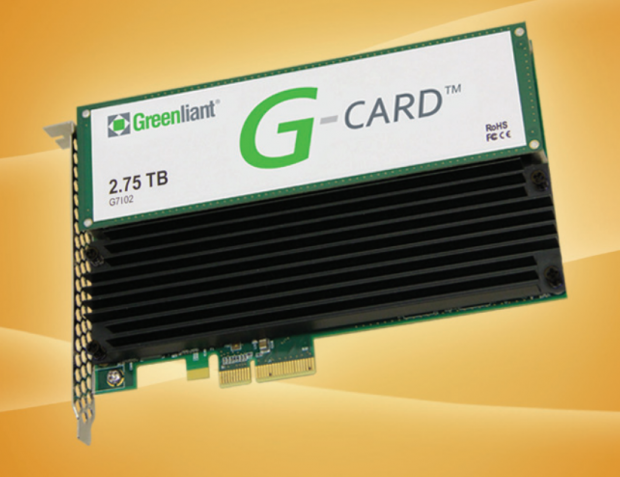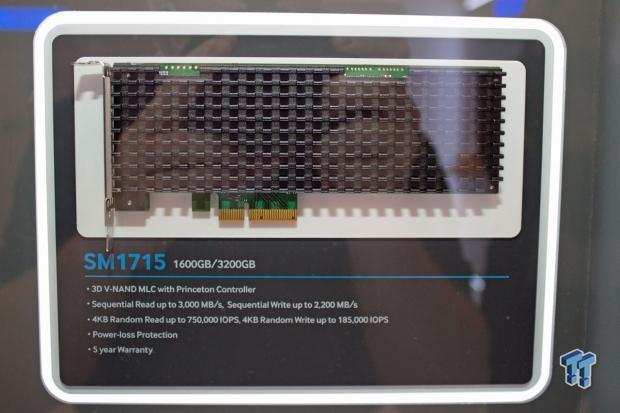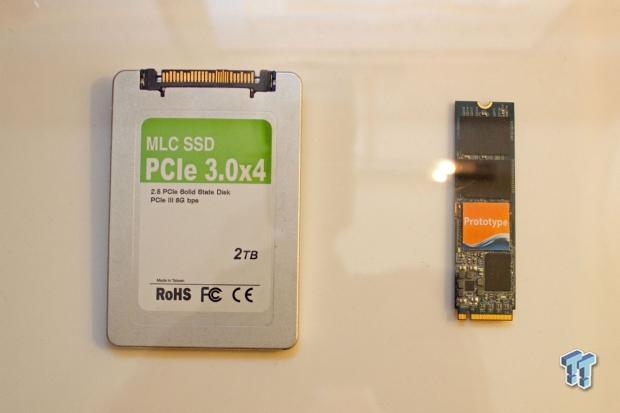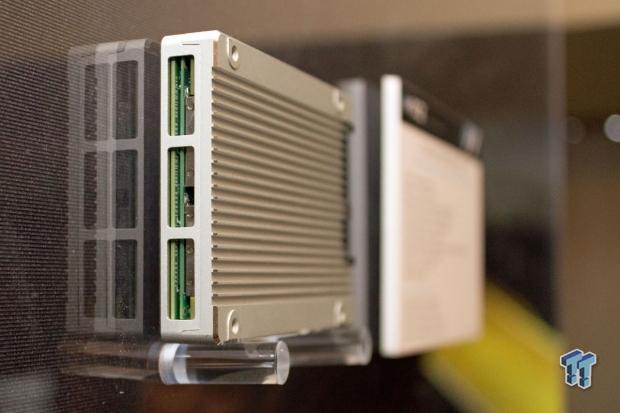IT/Datacenter & Super Computing News - Page 7
Supermicro shows off its latest GPU machines at NVIDIA GTC 2015
GTC 2015 - Today at NVIDIA GTC 2015, we stopped by Supermicro's booth to look at the latest Tesla GPU Superservers. As always, Supermicro has a wide variety of servers and workstations to meet the needs of its customers.
Sumit Gupta, general manager of Accelerated Computing at NVIDIA explained to us: "Supermicro's new high-density servers provide a range of computing solutions for enterprise and HPC customers," he continued: "Designed to take full advantage of ultra-high performance Tesla GPU accelerators while minimizing power consumption, the servers bring new levels of energy-efficient performance for compute-intensive data analytics, deep learning and scientific applications."
The first offering is the SYS-7048GR-TR, 4U Dual Processor GPU SuperWorkstation with 4-Way GeForce SLI Support.
Continue reading: Supermicro shows off its latest GPU machines at NVIDIA GTC 2015 (full post)
One Stop Systems shows off its 16 GPU monster machine at GTC 2015
GTC 2015 - Walking around at NVIDIA GTC 2015 you could not help but notice the 16x GPU Compute Accelerator from One Stop Systems. These external GPU accelerators are used in applications like seismic modeling, trading algorithms and research.
The showstopper is One Stop Systems High Density Compute Accelerator (HDCA), which can accommodate up to 16 NVIDIA Tesla K80s. This beast of a machine includes dual redundant 6,000watt PSUss to power all those GPUss. The interface for these systems is One Stop Systems PCIe expansion card, which is used to connect One Stops Systems to a host machine to expand its GPU capabilities.
One Stop Systems feature smaller GPU boxes called "The Cube". These boxes expand a systems GPU capability by using OSS's PCIe expansion card and come in many different sized boxes from the pCUBE with 1x GPU all the way up to The CUBE3 supporting 8x GPUs.
Continue reading: One Stop Systems shows off its 16 GPU monster machine at GTC 2015 (full post)
The Trinity Supercomputer calls for some serious water cooling
This massive stockpile of components will all be slotted nicely together in order to cool the NNSA's first Advanced Simulation and Computing Program's product - named the Trinity Supercomputer.
All of this gear is called 'warm-water cooling' and it's what you'd expect in order to provide an energy-saving alternative for some of the world's most advanced tech.
An explanation from the Los Alamos National Labarotory reads: "The Trinity supercomputer is the first of the NNSA's Advanced Simulation and Computing program's advanced technology systems. Once installed, Trinity will be the first platform large and fast enough to begin to accommodate finely resolved 3D calculations for full-scale, end-to-end weapons calculations. But the installation of such a powerful supercomputer is no small task." But wait, there's more! "In order to accommodate Trinity, the SCC first had to undergo a series of major mechanical and electrical infrastructure upgrades. Because energy conservation is a priority at Los Alamos, these upgrades included a shift to warm water cooling technology (which will result in a major energy savings), as well as a decrease in the use of city/well water for cooling towers.."
Continue reading: The Trinity Supercomputer calls for some serious water cooling (full post)
Microsoft Windows 10 Enterprise versions will not be free
Microsoft pleased the world at large by announcing a free upgrade to Windows 10 for consumers with Windows 7, 8, and 8.1. Unfortunately, Microsoft will not be extending that same offer to enterprise users.
Microsoft has released a statement on the issue, "Windows 7 Enterprise and Windows 8/8.1 Enterprise are not included in the terms of free Windows 10 Upgrade offer we announced last week, given active Software Assurance customers will continue to have rights to upgrade to Windows 10 enterprise offerings outside of this offer - while also benefitting from the full flexibility to deploy Windows 10 using their existing management infrastructure."
Microsoft is releasing a new two-tier enterprise updating feature. The 'Current Branch for Business' feature allows users to defer new updates for 120 days while they are thoroughly tested in client versions of the operating system. The operating system will still receive up-to-date security updates.
Continue reading: Microsoft Windows 10 Enterprise versions will not be free (full post)
Intel releases DC S3710 and DC S3610 SSDs
Intel is refreshing their datacenter SSD line with new models that deliver faster write performance than their predecessors. The Intel DC S3710 Series provides 25% more write performance, topping out at 45,000 random write IOPS for the 1.2TB model. The DC S3710 SSDs come in capacities of 200, 400, 800, and 1.2TB. Random read performance weighs in at 85,000 IOPS, and sequential read weighs in at 550MB/s, and sequential writes vary by capacity points, reaching a top speed of 520MB/s. The DC S3710 is geared for high-performance computing, high data rate analytics, operational databases, and large-scale virtualization.
The Intel DC S3610 Series addresses the exploding mid-level performance tier, while offering faster random write speed with an economical price point. The DC S3610 comes in wide range of capacities, with 200, 400, 480, 800GB, and 1.2TB models in the 2.5" form factor. Random read tops out at 84,000 IOPS, and varying write performance (based upon capacity) reaches up to 28,000 IOPS. Sequential read comes in at 550MB/s, and sequential write performance reaches 520MB/s (depending upon capacity). The DC S3610 series also offers capacities of 200, 400, and 800GB in the incredibly small 1.8" form factor, but performance specifications for the 1.8" haven't been released as of yet.
The DC S3610 is designed to meet the requirements for operational and analytical databases, virtualization, e-commerce, and cloud infrastructures. Both new SSDs feature standard 6Gb/s SATA connections and 20nm IMFT NAND. The DC S3710 provides up to 10 DWPD of endurance, and the DC S3610 provides 3 DWPD. Both new SSDs come with power fail protection and a high level of reliability. In fact, Intel is one of the only storage manufacturers to provide concrete failure rate data to the public.
Continue reading: Intel releases DC S3710 and DC S3610 SSDs (full post)
Greenliant Systems releases G-card NVMe SSDs
Greenliant is introducing their new G7100 Series G-card, a high-capacity NVMe SSD that leverages an array of NANDrive SSDs in a PCIe form factor. Each NANDrive is it's own entity with its own embedded controller and ECC capability. This creates a scalable architecture that offers up to 2.75TB of storage.
The use of a distributed architecture provides built-in RAID functionality, which increases speed and improves reliability. Greenliant claims the new card offers an Uncorrectable Bit Error Rate (UBER) of 1 sector per 10E28, which is orders of magnitude higher than competing solutions. The G-card also features host power loss protection, and utilizes standard MLC NAND to deliver 10 Drive Writes Per Day (DWPD) of endurance. Speeds and feeds indicate the G-card won't set any performance records, but is geared more for reliability and an economical price point. The G-Card features 875 MB/s of sequential read speed, and 850 MB/s for sequential write. Random 4k reads weigh in at 130,000 IOPS, and random writes are 60,000 IOPS.
The card connects via the PCIe 2.0 connection at x4, and features a five-year warranty. The G-card is also bootable on multiple platforms.
Continue reading: Greenliant Systems releases G-card NVMe SSDs (full post)
Samsung displays new enterprise SSD offerings at CES 2015
CES 2015 -Samsung had several enterprise SSDs on display in their meeting rooms, highlighting the wide range of storage options they provide. Samsung has all the connectivity bases covered for SATA, SAS, and PCIe.
NVMe SSDs always attracts my immediate attention. NVMe is a hot topic, as outlined in our Defining NVMe Article. Pairing the refined and efficient interface with exciting new NAND technologies is exciting, and the SM1715 comes with massive capacities of 1.6 and 3.2TB. The SM1715 comes in the familiar HHHL form factor, and cramming all of that capacity into such a small space is made possible by Samsung's 3D V-NAND. Readers can find deeper analysis of V-NAND in The V-NAND Paradigm Shift Whitepaper. The SM1715's obligatory feeds and speeds are 750,000/185,000 random read/write IOPS and a sequential read/write speed of 3,000/2,200 MB/s, but NVMe advantages of reduced CPU overhead, in-box driver support in leading operating systems, and refined latency performance are also a big attraction.
M.2 offers the same NVMe goodness in a slimmer form factor , which is generating incredible interest for hyperscale deployments. The Samsung SM953 packs 480GB of 1x nm planar MLC NAND flash, but this inaugural design will likely be augmented with 3D V-NAND in the future. The UBX controller delivers sequential read/write speeds of 1,750/750 MB/s, and random read speed weighs in at 250,000 IOPS. Random write speeds haven't been disclosed as of yet, but the SM953 also features power loss protection. The race is on for the first datacenter-class M.2 SSD to hit the market, and look to these pages soon for an evaluation of the first one to hit our labs.
Continue reading: Samsung displays new enterprise SSD offerings at CES 2015 (full post)
Phison shows new enterprise NVMe SSD controller supporting TLC
CES 2015 -Phison is poised to make waves with their new PS5007-E7 controller. This new controller will power enterprise NVMe SSDs in both the M.2 and 2.5" form factors, with the latter sporting the new SFF-8639 connector. The controller will provide plenty of bandwidth with a PCIe 3.0 x4 connection. The new controllers support capacities from 16GB all the way up to 2TB. Sequential reads are rated for 2,800 MB/s, and sequential writes come in at 1,500 MB/s. The controller also features random read/write speeds of 350,000/300,000 IOPS.
The controller supports both AHCI 1.3 and NVMe 1.1. Current designs do not include power capacitors, but power loss protection will be included in the final designs. It is also only rational that an NVMe controller with this type of grunt power will eventually make its way to a standard PCIe form factor product, but we did not receive official confirmation of that possibility. The M.2 form factor is starting to pop up in roadmaps of more manufacturers for enterprise applications, so there is definitely an emerging customer base for these products as well.
An interesting tidbit of info is in the flash the controller supports. First, the controller is being qualified with Toshiba A19 MLC and TLC. There aren't any TLC NVMe SSDs with the SFF-8639 connector as of yet, but the transition to TLC will help lower cost, thus speeding NVMe adoption. The second interesting item is Phison is working on qualifying another type of NAND as well, but covered up the listing on the spec card. We were informed this is due to that particular manufacturer not being ready to announce the product, so Phison may be working with 3D NAND as well.
Continue reading: Phison shows new enterprise NVMe SSD controller supporting TLC (full post)
OCZ Storage Solutions Z-Drive 6000 NVMe SSD on display at CES 2015
CES 2015 -OCZ Storage Solutions displayed the Z-Drive 6000 NVMe SSD in their suite at CES 2015. The Z-Drive 6000 sports speeds of 3,000 MB/s for sequential read and 2,000 MB/s for sequential write workloads. Random reads weigh in at an outstanding 700,000 IOPS, and random writes are equally impressive at 175,000 IOPS. The Z-Drive 6000 will provide 1-3 DWPD, which is becoming the standard for most datacenter SSDs, largely due to increased density. The Z-Drive 6000 utilizes the NVMe interface, covered in detail in our Defining NVMe article.
The Z-Drive 6000 comes in capacities of 800GB, 1.6TB and 3.2TB in the small 2.5" 15mm form factor. The Z-Drive leverages the proven PMC-Sierra Princeton controller running OCZ-proprietary firmware. The Z-Drive 6000 is certified for NVMe specification 1.1b on the UNH-IOL integrator list. The drive also features all the normal enterprise trimmings, such as encryption and internal data redundancy.
The end of the SSD reveals a row of open slots that take advantage of the native linear airflow patterns inside the server. 2.5" PCIe SSDs use ExpressBay, a multi-protocol externally accessible storage slot that supports 2.5" or 3.5" devices compatible with the SFF-8639 connector. Standard drive bays are limited to 9 Watts of power, but ExpressBay bumps that up to 25 Watts, which is also the limit for the Z-Drive 6000. The Z-Drive also features optional lower power states. ExpressBay also provides additional airflow to dissipaten more heat. The unique airflow implementation for the Z-Drive 6000 will help to keep the drive cool and avoid any thermal throttling issues.
Continue reading: OCZ Storage Solutions Z-Drive 6000 NVMe SSD on display at CES 2015 (full post)
Samsung displays cutting-edge TLC 3D V-NAND wafers at CES 2015
CES 2015 -Samsung has the advantage, for the time being, of being the only manufacturer shipping 3D NAND products. V-NAND is 3D NAND that achieves better density, performance, endurance, and power consumption, via vertical stacking of the NAND cells and CTF technology. This runs counter to the established norm of increasing density through NAND shrinks, and with good reason. Shrinks provide more density, but actually reduce endurance.
We have a more detailed analysis of V-NAND in The V-NAND Paradigm Shift article. Samsung has the 10nm class MLC NAND 16Gb and the 32-layer 128Gb TLC 3D V-NAND on display. The TLC (or 3bit) versions of V-NAND boost capacity, and also provide increased endurance in comparison to standard planar TLC NAND. Planar TLC has already made its way into the client and enterprise space despite the lower endurance, and 3D TLC V-NAND is on the way to the datacenter as well.
The 3D TLC V-NAND packages top out at 128Gb, and Intel has announced a move up to 256Gb. Samsung is also working on denser dies, but further details aren't available at this time. Current planar NAND designs feature a maximum density of 128Gbit per chip, but V-NAND is expected to enable up to 1Tb per chip by 2017. Toshiba also has 3D NAND on the roadmap, so the battle for 3D NAND supremacy is well underway.
Continue reading: Samsung displays cutting-edge TLC 3D V-NAND wafers at CES 2015 (full post)





